Karyotype and Phylogenetic Relationship Analysis of Five Varieties and Cultivars of Zanthoxylum armatum Based on Oligo-FISH
Abstract
1. Introduction
2. Materials and Methods
2.1. Plant Materials
2.2. FISH
2.3. Genetic Relationships
3. Results
3.1. Flower Bud and Fruit Morphology of Z. armatum
3.2. Karyotype of Z. armatum
3.3. Oligonucleotide Signal Number of Different Z. armatum Materials
4. Discussions
4.1. Inconsistent Chromosome Number of Five Z. armatum Materials
4.2. Divergence Stages of Five Z. armatum Materials
4.3. Oligonucleotide Signal Differences of Five Z. armatum Materials
4.4. Distinction of Varieties and Cultivars of Z. armatum based on Chromosome Number and Oligonucleotide Signal
5. Conclusions
Author Contributions
Funding
Institutional Review Board Statement
Informed Consent Statement
Data Availability Statement
Acknowledgments
Conflicts of Interest
References
- Wu, G.A.; Terol, J.; Ibanez, V.; López-García, A.; Pérez-Román, E.; Borredá, C.; Domingo, C.; Tadeo, F.R.; Carbonell-Caballero, J.; Alonso, R.; et al. Genomics of the origin and evolution of Citrus. Nature 2018, 554, 311–316. [Google Scholar] [CrossRef] [PubMed]
- Wang, X.; Xu, Y.; Zhang, S.; Cao, L.; Huang, Y.; Cheng, J.; Wu, G.; Tian, S.; Chen, C.; Liu, Y. Genomic analyses of primitive, wild and cultivated Citrus provide insights into asexual reproduction. Nat. Genet. 2017, 49, 765–772. [Google Scholar] [CrossRef] [PubMed]
- Luo, X.M.; Liu, J.C.; Wang, J.Y.; Gong, W.; Chen, L.; Wan, W.L. FISH analysis of Zanthoxylum armatum based on oligonucleotides for 5S rDNA and (GAA)6. Genome 2018, 61, 699–702. [Google Scholar] [CrossRef] [PubMed]
- Zhang, M.; Wang, J.; Zhu, L.; Li, T.; Jiang, W.; Zhou, J.; Peng, W.; Wu, C. Zanthoxylum bungeanum Maxim. (Rutaceae): A systematic review of its traditional uses, botany, phytochemistry, pharmacology, pharmacokinetics, and toxicology. Int. J. Mol. Sci. 2017, 18, 2172. [Google Scholar] [CrossRef] [PubMed]
- Fei, X.; Shi, Q.; Yang, T.; Fei, Z.; Wei, A. Expression stabilities of ten Candidate reference genes for RT-qPCR in Zanthoxylum bungeanum Maxim. Molecules 2018, 23, 802. [Google Scholar] [CrossRef] [PubMed]
- Chruma, J.J.; Cullen, D.J.; Bowman, L.; Toy, P.H. Polyunsaturated fatty acid amides from the Zanthoxylum genus—From culinary curiosities to probes for chemical biology. Nat. Prod. Rep. 2018, 35, 54–74. [Google Scholar] [CrossRef] [PubMed]
- Plazas, E.; Hagenow, S.; Murillo, M.A.; Stark, H.; Cuca, L.E. Isoquinoline alkaloids from the roots of Zanthoxylum rigidum as multi-target inhibitors of cholinesterase, monoamine oxidase A and Aβ1-42 aggregation. Bioorganic Chem. 2020, 98, 103722. [Google Scholar] [CrossRef]
- Xiang, L.; Liu, Y.; Xie, C.; Li, X.; Yu, Y.; Ye, M.; Chen, S. The chemical and genetic characteristics of szechuan pepper (Zanthoxylum bungeanum and Z. armatum) Cultivars and Their Suitable Habitat. Front. Plant Sci. 2016, 7, 467. [Google Scholar] [CrossRef]
- Ye, M. Development status and prospect of Sichuan pepper industry. China Rural. Sci. Technol. 2020, 2020, 70–73. Available online: http://www.cnki.com.cn/Article/CJFDTOTAL-JKCN202009020.htm (accessed on 8 April 2023).
- Li, J.; Li, S.; Kong, L.; Wang, L.; Wei, A.; Liu, Y. Genome survey of Zanthoxylum bungeanum and development of genomic-SSR markers in congeneric species. Biosci. Rep. 2020, 40, BSR20201101. [Google Scholar] [CrossRef]
- Phuyal, N.; Jha, P.K.; Raturi, P.P.; Rajbhandary, S. Zanthoxylum armatum DC.: Current knowledge, gaps and opportunities in Nepal. J. Ethnopharmacol. 2018, 229, 326–341. [Google Scholar] [CrossRef] [PubMed]
- Nooreen, Z.; Tandon, S.; Yadav, N.P.; Kumar, P.; Xuan, T.D.; Ahmad, A. Zanthoxylum: A Review of its Traditional Uses, Naturally Occurring Constituents and Pharmacological Properties. Curr. Org. Chem. 2019, 23, 1307–1341. [Google Scholar] [CrossRef]
- Feng, S.; Liu, Z.; Hu, Y.; Tian, J.; Yang, T.; Wei, A. Genomic analysis reveals the genetic diversity, population structure, evolutionary history and relationships of Chinese pepper. Hortic. Res. 2020, 7, 1–20. [Google Scholar] [CrossRef] [PubMed]
- Luo, X.; Liu, J.; Zhao, A.; Chen, X.; Wan, W.; Chen, L. Karyotype analysis of Piptanthus concolor based on FISH with a oligonucleotides for rDNA 5S. Sci. Hortic. 2017, 226, 361–365. [Google Scholar] [CrossRef]
- Guerra, M. Chromosome numbers in plant cytotaxonomy: Concepts and implications. Cytogenet. Genome Res. 2008, 120, 339–350. [Google Scholar] [CrossRef]
- Rice, A.; Glick, L.; Abadi, S.; Einhorn, M.; Kopelman, N.M.; Salman-Minkov, A.; Mayzel, J.; Chay, O.; Mayrose, I. The Chromosome Counts Database (CCDB)—A community resource of plant chromosome numbers. New Phytol. 2015, 206, 19–26. [Google Scholar] [CrossRef]
- Zhang, D.X.; Hartley, G.T. Zanthoxylum Linnaeus. In Flora of China; Flora of China Editorial Committee, Ed.; Science Press: Beijing, China; Missouri Botanical Garden Press: St. Louis, MO, USA, 2008; pp. 53–66. Available online: http://foc.eflora.cn/content.aspx?TaxonId=135262 (accessed on 8 April 2023).
- Yu, L.Y.; Tan, X.M.; Zhou, Y.Q. Karyotype analysis of Z. nitidum. Lishizhen Med. Mater. Med. Res. 2010, 21, 3284–3285. [Google Scholar]
- Chen, R.Y.; Chen, C.B.; Song, W.Q.; Liang, G.L.; Li, X.L.; Chen, L. Chromosome atlas of major economic plants genome in China (Tomus V). In Chromosome Atlas of Medicinal Plants in China; Li, S.W., Wang, J., Eds.; Science Press: Beijing, China, 2009; p. 636. [Google Scholar]
- Hu, L.; Xu, Z.; Fan, R.; Wang, G.; Wang, F.; Qin, X.; Yan, L.; Ji, X.; Meng, M.; Sim, S.; et al. The complex genome and adaptive evolution of polyploid Chinese pepper (Zanthoxylum armatum and Zanthoxylum bungeanum). Plant Biotechnol. J. 2023, 21, 78–96. [Google Scholar] [CrossRef]
- Feng, S.J.; Liu, Z.S.; Cheng, J.; Li, Z.H.; Tian, L.; Liu, M.; Yang, T.X.; Liu, Y.H.; Liu, Y.L.; Dai, H.; et al. Zanthoxylum- specific whole genome duplication and recent activity of transposable elements in the highly repetitive paleotetraploid Z. bungeanum genome. Hortic. Res. 2021, 8, 205. [Google Scholar] [CrossRef]
- Iwata-Otsubo, A.; Radke, B.; Findley, S.; Abernathy, B.; Vallejos, C.E.; Jackson, S.A. Fluorescence in Situ Hybridization (FISH)-based karyotyping reveals rapid evolution of centromeric and subtelomeric repeats in common Bean (Phaseolus vulgaris) and relatives. G3 Genes|Genomes|Genetics 2016, 6, 1013–1022. [Google Scholar] [CrossRef]
- She, C.-W.; Wei, L.; Jiang, X.-H. Molecular cytogenetic characterization and comparison of the two cultivated Canavalia species (Fabaceae). Comp. Cytogenet. 2017, 11, 579–600. [Google Scholar] [CrossRef]
- Zhou, H.C.; Pellerin, R.J.; Waminal, N.E.; Yang, T.-J.; Kim, H.H. Pre-labelled oligo probe-FISH karyotype analyses of four Araliaceae species using rDNA and telomeric repeat. Genes Genom. 2019, 41, 839–847. [Google Scholar] [CrossRef] [PubMed]
- Abirached-Darmency, M.; Prado-Vivant, E.; Chelysheva, L.; Pouthier, T. Variation in rDNA locus number and position among legume species and detection of 2 linked rDNA loci in the model Medicago truncatula by FISH. Genome 2005, 48, 556–561. [Google Scholar] [CrossRef] [PubMed]
- Robledo, G.; Lavia, G.I.; Seijo, G. Species relations among wild Arachis species with the A genome as revealed by FISH mapping of rDNA loci and heterochromatin detection. Theor. Appl. Genet. 2009, 118, 1295–1307. [Google Scholar] [CrossRef] [PubMed]
- Cai, Q.; Zhang, D.; Liu, Z.-L.; Wang, X.-R. Chromosomal localization of 5S and 18S rDNA in five species of subgenus strobus and their implications for genome evolution of Pinus. Ann. Bot. 2006, 97, 715–722. [Google Scholar] [CrossRef]
- Lan, Y.; Lianwei, Q.; Xin, H.; Gong, H.; Lei, J.; Xi, M. Physical mapping of rDNA and karyotype analysis in Tulipa sinkiangensis and T. schrenkii. Sci. Hortic. 2018, 240, 638–644. [Google Scholar] [CrossRef]
- Luo, X.; Liu, J.; He, Z. Oligo-FISH can identify chromosomes and distinguish Hippophaë rhamnoides L. Taxa. Genes 2022, 13, 195. [Google Scholar] [CrossRef]
- Luo, X.; Chen, J. Distinguishing Sichuan walnut cultivars and examining their relationships with Juglans regia and J. sigillata by FISH, early-fruiting gene analysis, and SSR analysis. Front. Plant Sci. 2020, 11, 27. [Google Scholar] [CrossRef]
- He, Z.; Zhang, W.; Luo, X.; Huan, J. Five Fabaceae karyotype and phylogenetic relationship analysis based on oligo-FISH for 5S rDNA and (AG3T3)3. Genes 2022, 13, 768. [Google Scholar] [CrossRef]
- Braz, G.T.; He, L.; Zhao, H.; Zhang, T.; Semrau, K.; Rouillard, J.M.; Torres, G.A.; Jiang, J. Comparative oligo-FISH mapping: An efficient and powerful methodology to reveal karyotypic and chromosomal evolution. Genetics 2018, 208, 513–523. [Google Scholar] [CrossRef]
- Song, R.; Jia, X.J.; Shao, Y.C. Study of extraction, antimicrobial activities of essential oil from Zanthoxylu bungeanum Maxim and GC-MS. Chin. Agric. Sci. Bull. 2014, 2014, 263–270. Available online: http://www.cnki.com.cn/Article/CJFDTOTAL-ZNTB201421047.htm (accessed on 8 April 2023).
- Hand, M.L.; Koltunow, A.M.G. The genetic control of apomixis: Asexual seed formation. Genetics 2014, 197, 441–450. [Google Scholar] [CrossRef] [PubMed]
- Fei, X.; Shi, J.; Liu, Y.; Niu, J.; Wei, A. The steps from sexual reproduction to apomixis. Planta 2019, 249, 1715–1730. [Google Scholar] [CrossRef] [PubMed]
- Qiu, C.S.; Cheng, C.H.; Zhao, L.N.; Li, Y.J.; Zang, G.G. Study on chromosome behavior in polyploidy of apomictic Boehmeria tricuspis. J. Plant Genet. Res. 2013, 14, 577–580. [Google Scholar] [CrossRef]
- Luo, M.C.; Deal, K.R.; Akhunov, E.D.; Akhunova, A.R.; Anderson, O.D.; Anderson, J.A.; Blake, N.; Clegg, M.T.; Coleman-Derr, D.; Conley, E.J.; et al. Genome comparisons reveal a dominant mechanism of chromosome number reduction in grasses and accelerated genome evolution in Triticeae. Proc. Natl. Acad. Sci. USA 2009, 106, 15780–15785. [Google Scholar] [CrossRef]
- Sharma, P.; Sharma, N. Aneusomaty and chromosomal chimeras in male track of Coccinia grandis (L.) Voigt. Natl. Acad. Sci. Lett. 2021, 45, 191–194. [Google Scholar] [CrossRef]
- Pelsy, F. Molecular and cellular mechanisms of diversity within grapevine varieties. Heredity 2010, 104, 331–340. [Google Scholar] [CrossRef]
- Bennetzen, J.L. Mechanisms and rates of genome expansion and contraction in flowering plants. Genetica 2002, 115, 29–36. [Google Scholar] [CrossRef]
- Van de Peer, Y.; Maere, S.; Meyer, A. The evolutionary significance of ancient genome duplications. Nat. Rev. Genet. 2009, 10, 725–732. [Google Scholar] [CrossRef]
- Schnable, P.S.; Ware, D.; Fulton, R.S.; Stein, J.C.; Wei, F.; Pasternak, S.; Liang, C.; Zhang, J.; Fulton, L.; Graves, T.A.; et al. The B73 maize genome: Complexity, diversity, and dynamics. Science 2009, 326, 1112–1115. [Google Scholar] [CrossRef]
- Zhang, J.; Yu, C.; Krishnaswamy, L.; Peterson, T. Transposable Elements as Catalysts for Chromosome Rearrangements. Methods Mol. Biol. 2011, 701, 315–326. [Google Scholar] [CrossRef] [PubMed]
- Schubert, I.; Vu, G. Genome Stability and Evolution: Attempting a Holistic View. Trends Plant Sci. 2016, 21, 749–757. [Google Scholar] [CrossRef] [PubMed]
- Yang, P.; Su, X.; Liu, Y.P.; Wang, Y.N.; Hu, X.Y.; Chen, J.Y. Chromosome number and karyotype analysis from different populations of Littledalea racemose. Acta Agrestia Sin. 2022, 30, 1712–1720. Available online: http://www.cnki.com.cn/Article/CJFDTOTAL-CDXU202207012.htm (accessed on 8 April 2023).
- Wang, J.Y.; Gong, W.; Xiao, Q.W.; Hu, W.; Wang, Y.; Lu, C.Y.; Zhang, Y.Y.; Gou, G.J. A new cold tolerance green Chinese prickly ash cultivar ‘Hanyuan Putao Qingjiao’. Acta Hortic. Sin. 2016, 43, 1425–1426. [Google Scholar] [CrossRef]
- Shi, Z.J.; Du, H.H.; Fang, Y.X. The Heteromorphic Leaves of Broussonetia papyrifera and its Ecological Adaptation to Environment. J. Southwest China Norm. Univ. 2021, 46, 61–65. [Google Scholar] [CrossRef]
- Stebbins, G.L. Chromosomals Evolution in High Plants; Edward Arnold: London, UK, 1971; pp. 85–105. [Google Scholar]
- Li, T.J.; Qu, Y.; Wang, B.Y. Chromosome karyotype analysis of Camellia reticulata with different ploidy. J. Cent. S. Univ. For. Technol. 2023, 43, 167–174. [Google Scholar] [CrossRef]
- Schubert, I. Chromosome evolution. Curr. Opin. Plant Biol. 2007, 10, 109–115. [Google Scholar] [CrossRef] [PubMed]
- Armstrong, S.J.; Filatov, D.A. A cytogenetic view of sex chromosome evolution in plants. Cytogenet. Genome Res. 2008, 120, 241–246. [Google Scholar] [CrossRef]
- Liu, B.; Chen, C.; Li, X.; Qi, L.; Han, S. Karyotype analysis and physical mapping of 45S rDNA in eight species of Sophora, Robinia and Amorpha. Front. Biol. China 2006, 1, 290–294. [Google Scholar]
- Hasterok, R.; Wolny, E.; Hosiawa, M.; Kowalczyk, M.; Kulak-Ksiazczyk, S.; Ksiazczyk, T.; Heneen, W.K.; Maluszynska, J. Comparative Analysis of rDNA Distribution in chromosomes of various species of Brassicaceae. Ann. Bot. 2005, 97, 205–216. [Google Scholar] [CrossRef]
- Bustamante, F.d.O.; Nascimento, T.H.D.; Montenegro, C.; Dias, S.; Martins, L.D.V.; Braz, G.T.; Benko-Iseppon, A.M.; Jiang, J.; Pedrosa-Harand, A.; Brasileiro-Vidal, A.C. Oligo-FISH barcode in beans: A new chromosome identification system. Theor. Appl. Genet. 2021, 134, 3675–3686. [Google Scholar] [CrossRef] [PubMed]
- Martínez, J.; Vargas, P.; Luceño, M.; Cuadrado, Á. Evolution of Iris subgenus Xiphium based on chromosome numbers, FISH of nrDNA (5S, 45S) and trnL–trnF sequence analysis. Plant Syst. Evol. 2010, 289, 223–235. [Google Scholar] [CrossRef]
- He, J.; Lin, S.; Yu, Z.; Song, A.; Guan, Z.; Fang, W.; Chen, S.; Zhang, F.; Jiang, J.; Chen, F.; et al. Identification of 5S and 45S rDNA sites in Chrysanthemum species by using oligonucleotide fluorescence in situ hybridization (Oligo-FISH). Mol. Biol. Rep. 2021, 48, 21–31. [Google Scholar] [CrossRef]
- Garcia, S.; Gálvez, F.; Gras, A.; Kovařík, A.; Garnatje, T. Plant rDNA database: Update and new features. Database 2014, 2014, bau063. [Google Scholar] [CrossRef]
- Wolny, E.; Hasterok, R. Comparative cytogenetic analysis of the genomes of the model grass Brachypodium distachyon and its close relatives. Ann. Bot. 2009, 104, 873–881. [Google Scholar] [CrossRef] [PubMed]
- Li, K.P.; Wu, Y.X.; Zhao, H.; Wang, Y.; Lü, X.M.; Wang, J.M.; Xu, Y.; Li, Z.Y.; Han, Y.H. Cytogenetic relationships among Citrullus species in comparison with some genera of the tribe Benincaseae (Cucurbitaceae) as inferred from rDNA distribution patterns. BMC Evol. Biol. 2016, 16, 1–85. [Google Scholar] [CrossRef]
- Maragheh, F.P.; Janus, D.; Senderowicz, M.; Haliloglu, K.; Kolano, B. Karyotype analysis of eight cultivated Allium species. J. Appl. Genet. 2019, 60, 1–11. [Google Scholar] [CrossRef]
- Hizume, M.; Shibata, F.; Matsusaki, Y.; Garajova, Z. Chromosome identification and comparative karyotypic analyses of four Pinus species. Theor. Appl. Genet. 2002, 105, 491–497. [Google Scholar] [CrossRef]
- Zhang, Y.X.; Cheng, C.Y.; Li, J.; Yang, S.Q.; Wang, Y.Z.; Li, Z.A.; Chen, J.F.; Lou, Q.F. Chromosomal structures and repetitive sequences divergence in Cucumis species revealed by comparative cytogenetic mapping. BMC Genom. 2015, 16, 1–13. [Google Scholar] [CrossRef]
- Pinkel, D.; Straume, T.; Gray, J.W. Cytogenetic analysis using quantitative, high-sensitivity, fluorescence hybridization. Proc. Natl. Acad. Sci. USA 1986, 83, 2934–2938. [Google Scholar] [CrossRef]
- Thomas, H.M.; Harper, J.A.; Morgan, W.G. Gross chromosome rearrangements are occurring in an accession of the grass Lolium rigidum. Chromosom. Res. 2001, 9, 585–590. [Google Scholar] [CrossRef] [PubMed]
- Cuadrado, A.; Cardoso, M.; Jouve, N. Increasing the physical markers of wheat chromosomes using SSRs as FISH probes. Genome 2008, 51, 809–815. [Google Scholar] [CrossRef] [PubMed]
- Badaeva, E.D.; Amosova, A.V.; Goncharov, N.P.; Macas, J.; Ruban, A.S.; Grechishnikova, I.V.; Zoshchuk, S.A.; Houben, A. A Set of cytogenetic markers allows the precise identification of all a-genome chromosomes in diploid and polyploid wheat. Cytogenet. Genome Res. 2015, 146, 71–79. [Google Scholar] [CrossRef]
- Badaeva, E.D.; Ruban, A.S.; Zoshchuk, S.A.; Surzhikov, S.A.; Knüpffer, H.; Kilian, B. Molecular cytogenetic characterization of Triticum timopheevii chromosomes provides new insight on genome evolution of T. zhukovskyi. Plant Syst. Evol. 2016, 302, 943–956. [Google Scholar] [CrossRef]
- Shi, J.S.; Wang, Z.J.; Chen, J.H. Progress on whole genome sequencing in woody plants. Hereditas 2012, 34, 145–156. [Google Scholar] [CrossRef] [PubMed]
- Xu, Q.; Chen, L.L.; Ruan, X.; Chen, D.; Zhu, A.; Chen, C.; Bertrand, D.; Jiao, W.B.; Hao, B.H.; Lyon, M.P.; et al. The draft genome of sweet orange (Citrus sinensis). Nat. Genet. 2013, 45, 59–66. [Google Scholar] [CrossRef]
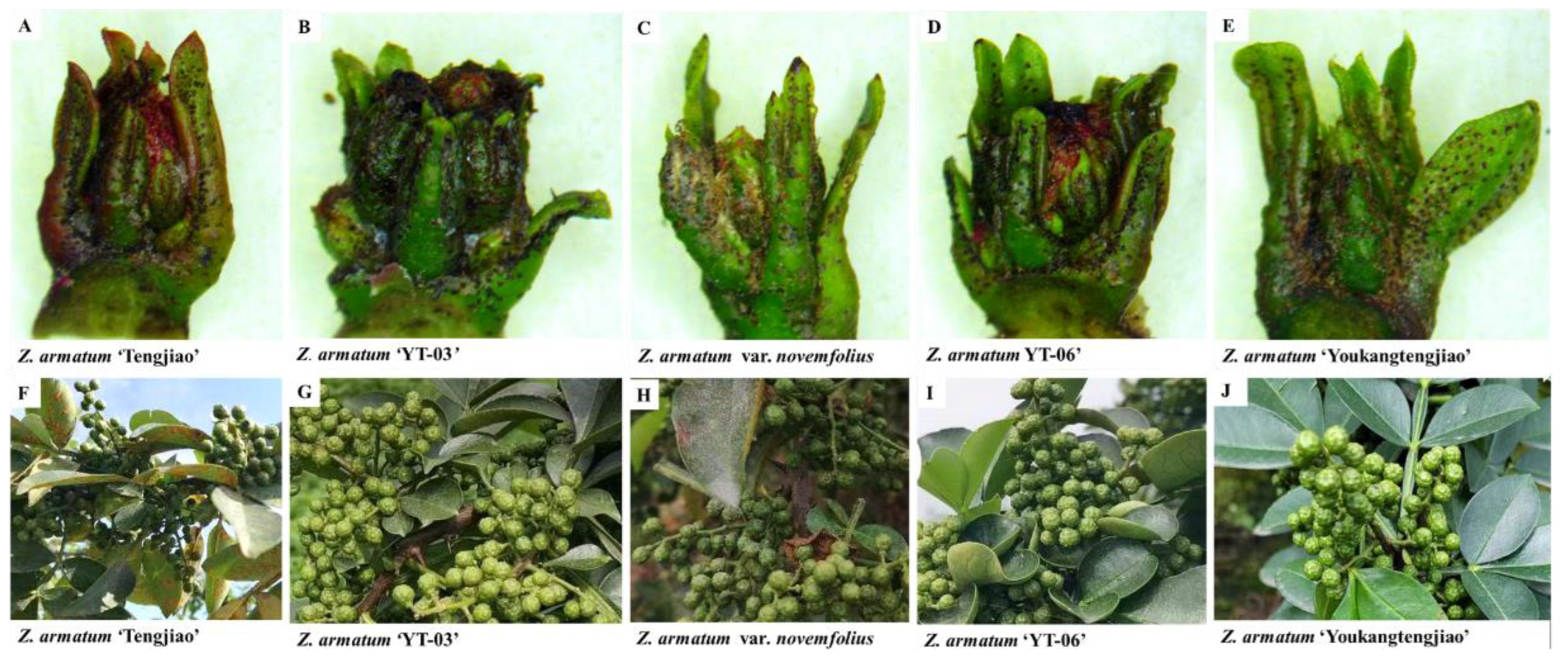
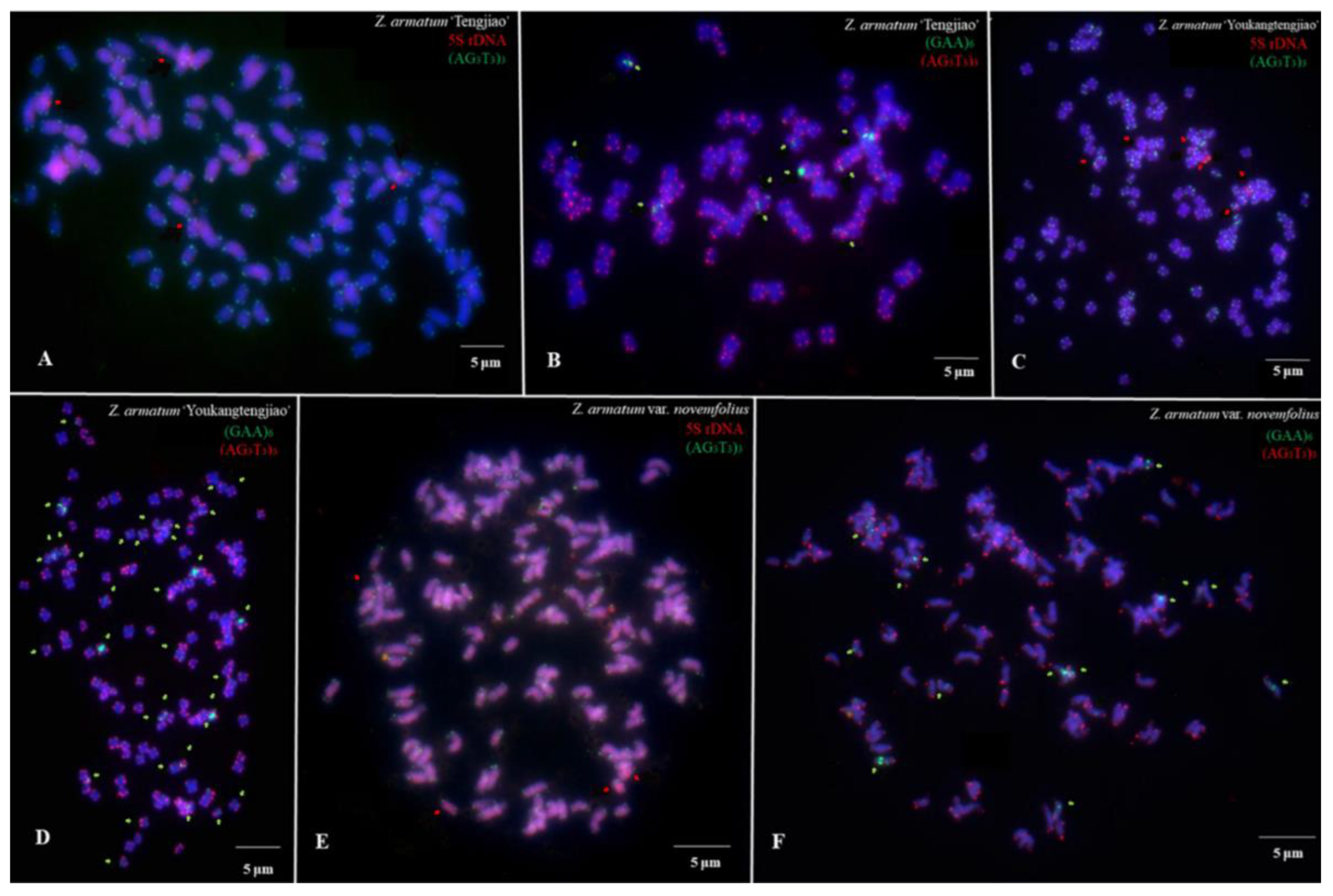
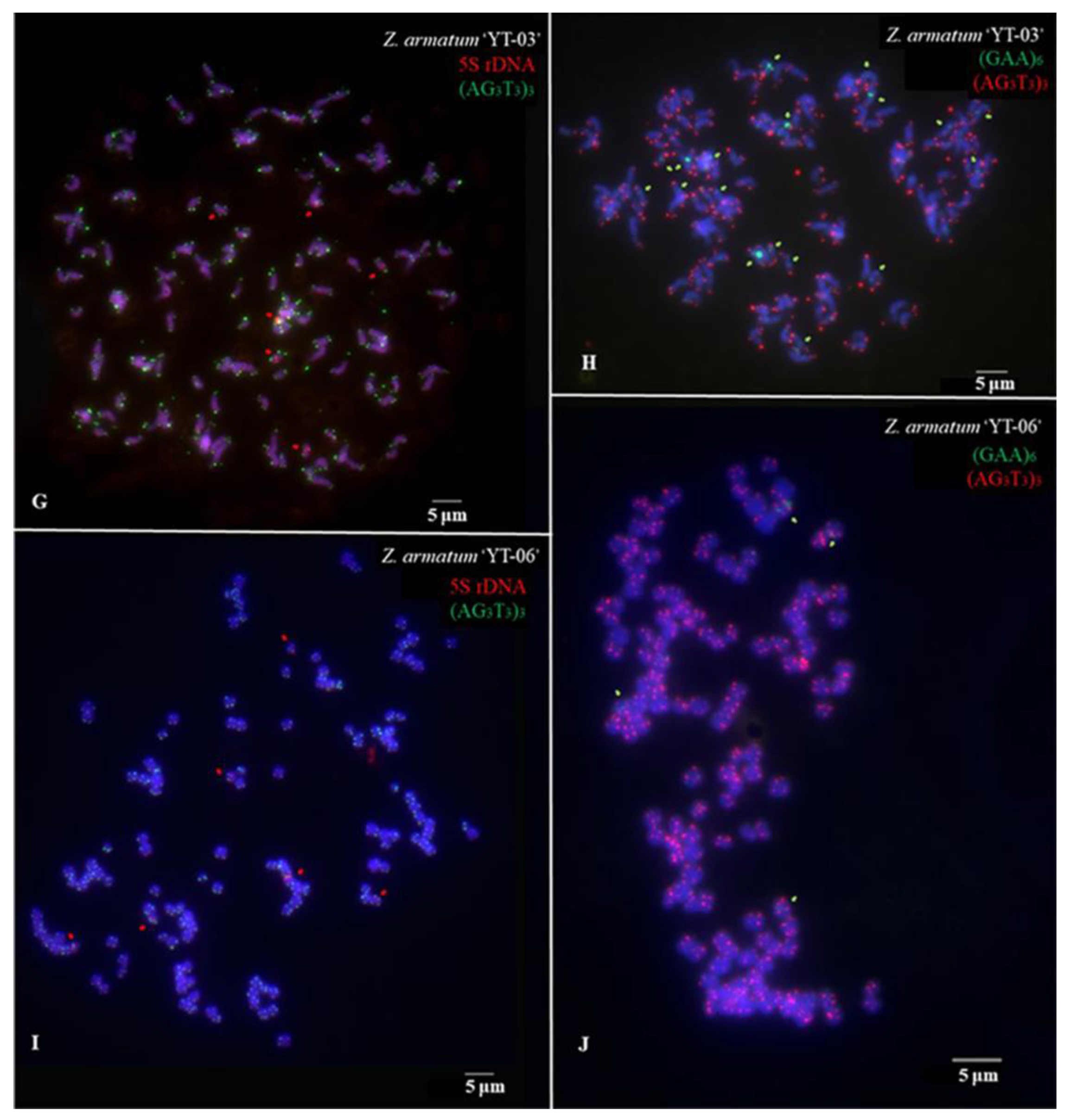
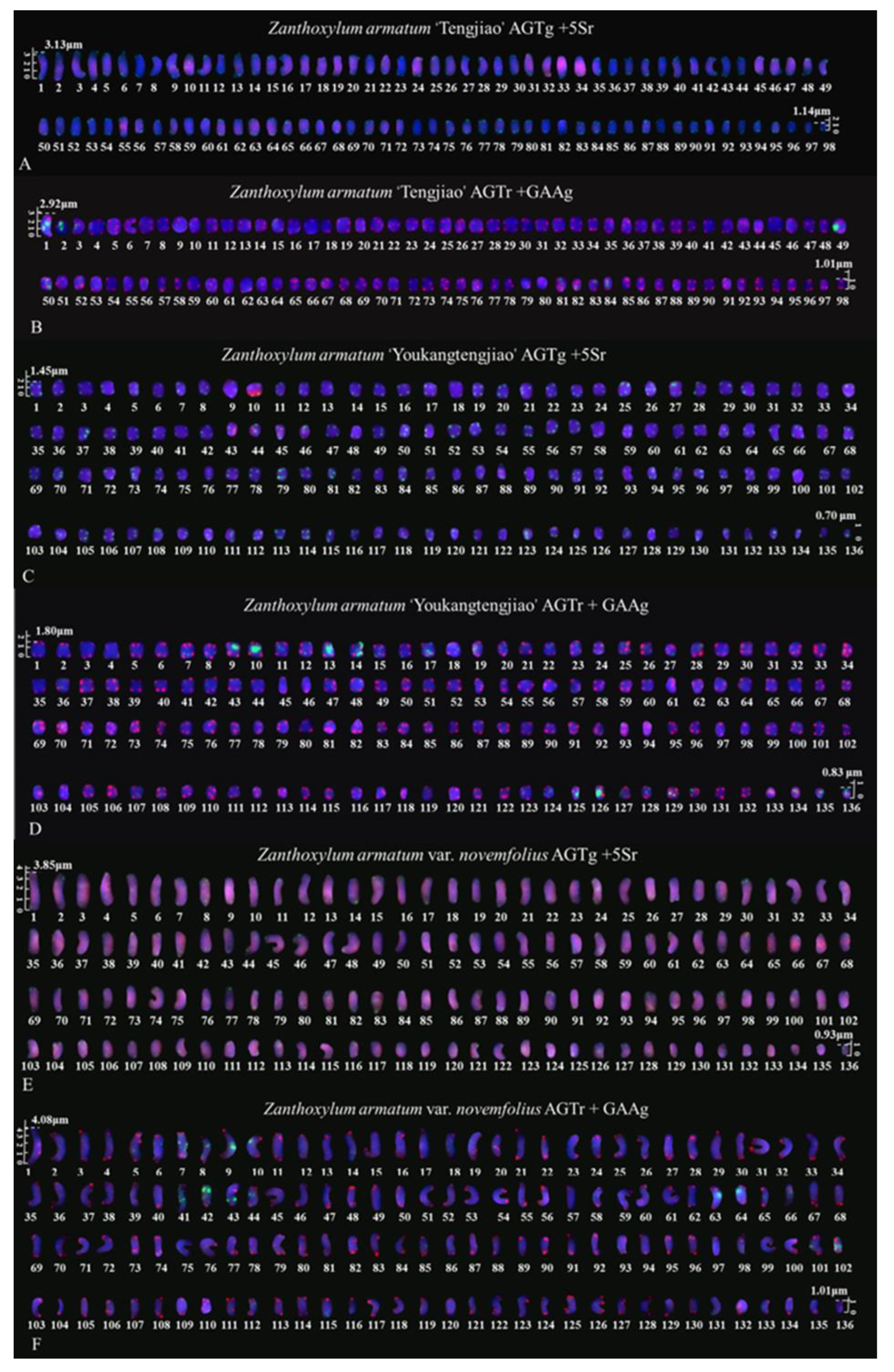
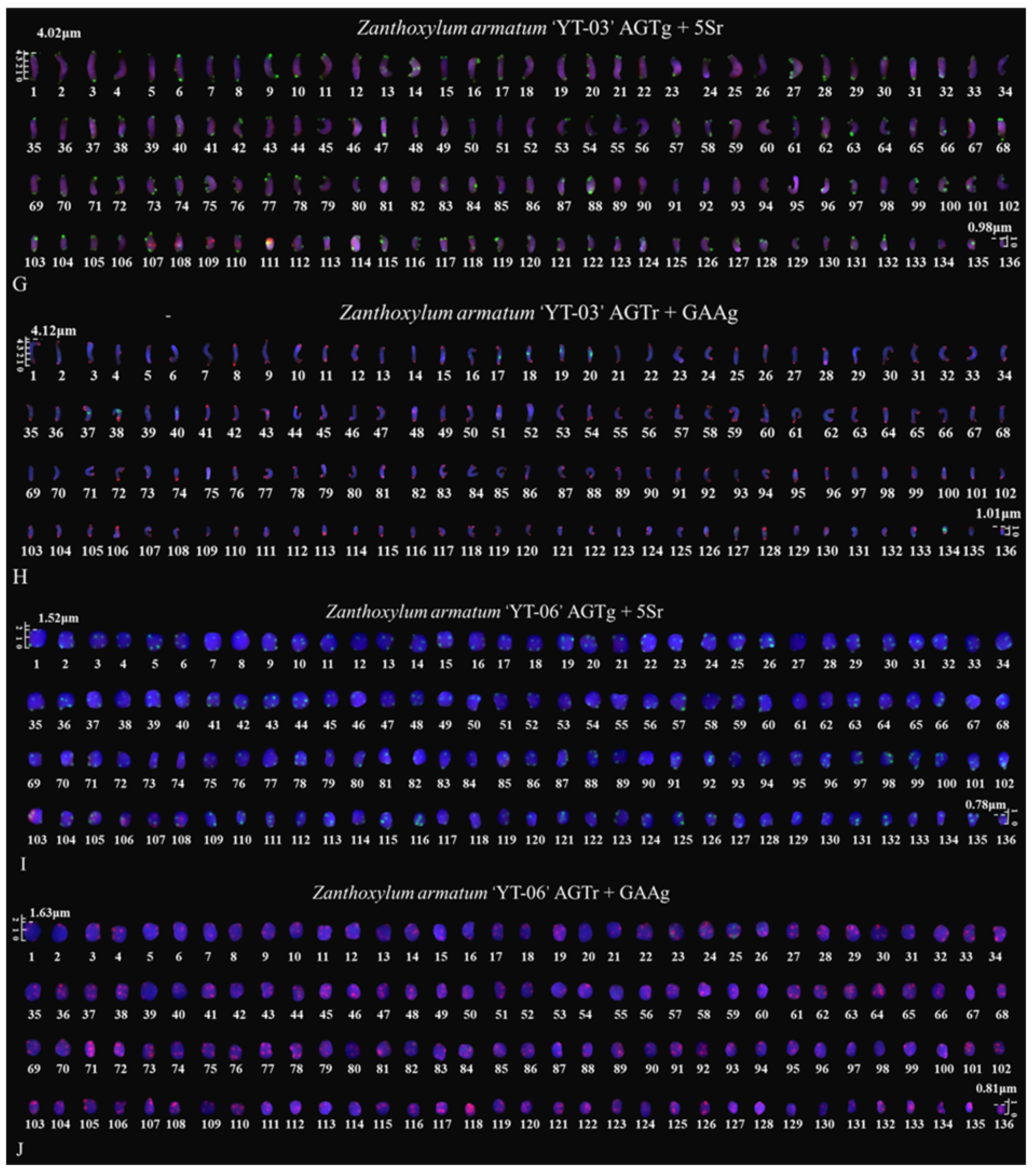
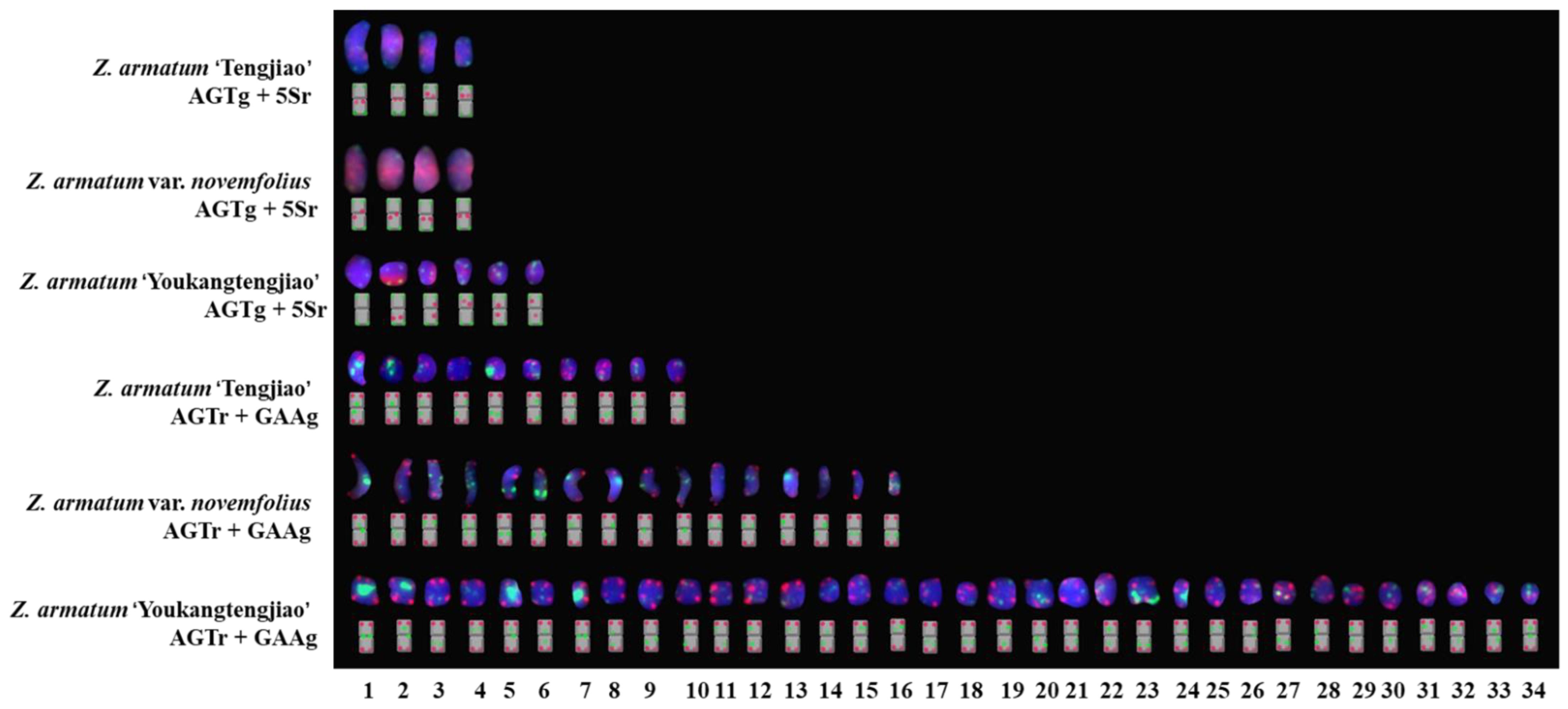
| No. | Latin Name | Type | Location | Geographical Coordinates |
|---|---|---|---|---|
| 1 | Z. armatum ‘Tengjiao’ | Seedling | Zigong City, Sichuan Province, China | 104°52′10″ E, 29°16′28″ N |
| 2 | Z. armatum ‘Youkangtengjiao’ | Seedling | Zigong City, Sichuan Province, China | 104°52′10″ E, 29°16′28″ N |
| 3 | Z. armatum var. novemfolius | Seedling | Zigong City, Sichuan Province, China | 104°52′10″ E, 29°16′28″ N |
| 4 | Z. armatum ‘YT-03’ | Seedling | Zigong City, Sichuan Province, China | 104°52′10″ E, 29°16′28″ N |
| 5 | Z. armatum ‘YT-06’ | Seedling | Zigong City, Sichuan Province, China | 104°52′10″ E, 29°16′28″ N |
| No. | Latin Name | Karyotype | Karyotype Type | Arm Ratio |
|---|---|---|---|---|
| 1 | Z. armatum var. novemfolius | 2n = 2x = 134m + 2sm | 1C | 5.5224 |
| 2 | Z. armatum ‘Tengjiao’ | 2n = 2x = 98m | 1C | 4.3237 |
| 3 | Z. armatum ‘YT-03’ | 2n = 2x = 2M + 128m + 4sm + 2st | 2C | 4.1829 |
| 4 | Z. armatum ‘Youkangtengjiao’ | 2n = 2x = 128m + 8sm | 2B | 3.5336 |
| 5 | Z. armatum ‘YT-06’ | 2n = 2x = 126m + 10sm | 2B | 3.3011 |
Disclaimer/Publisher’s Note: The statements, opinions and data contained in all publications are solely those of the individual author(s) and contributor(s) and not of MDPI and/or the editor(s). MDPI and/or the editor(s) disclaim responsibility for any injury to people or property resulting from any ideas, methods, instructions or products referred to in the content. |
© 2023 by the authors. Licensee MDPI, Basel, Switzerland. This article is an open access article distributed under the terms and conditions of the Creative Commons Attribution (CC BY) license (https://creativecommons.org/licenses/by/4.0/).
Share and Cite
He, Z.; Lei, Y.; Gong, W.; Ye, M.; Luo, X. Karyotype and Phylogenetic Relationship Analysis of Five Varieties and Cultivars of Zanthoxylum armatum Based on Oligo-FISH. Genes 2023, 14, 1459. https://doi.org/10.3390/genes14071459
He Z, Lei Y, Gong W, Ye M, Luo X. Karyotype and Phylogenetic Relationship Analysis of Five Varieties and Cultivars of Zanthoxylum armatum Based on Oligo-FISH. Genes. 2023; 14(7):1459. https://doi.org/10.3390/genes14071459
Chicago/Turabian StyleHe, Zhoujian, Yuting Lei, Wei Gong, Meng Ye, and Xiaomei Luo. 2023. "Karyotype and Phylogenetic Relationship Analysis of Five Varieties and Cultivars of Zanthoxylum armatum Based on Oligo-FISH" Genes 14, no. 7: 1459. https://doi.org/10.3390/genes14071459
APA StyleHe, Z., Lei, Y., Gong, W., Ye, M., & Luo, X. (2023). Karyotype and Phylogenetic Relationship Analysis of Five Varieties and Cultivars of Zanthoxylum armatum Based on Oligo-FISH. Genes, 14(7), 1459. https://doi.org/10.3390/genes14071459







